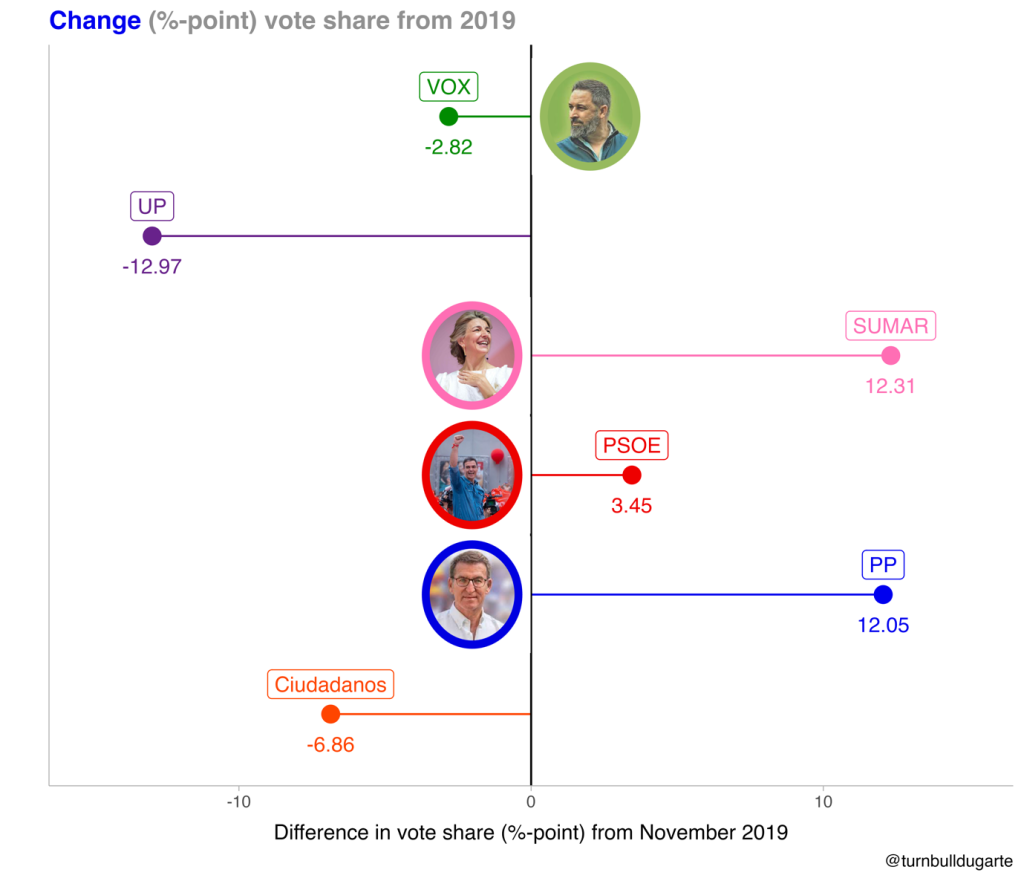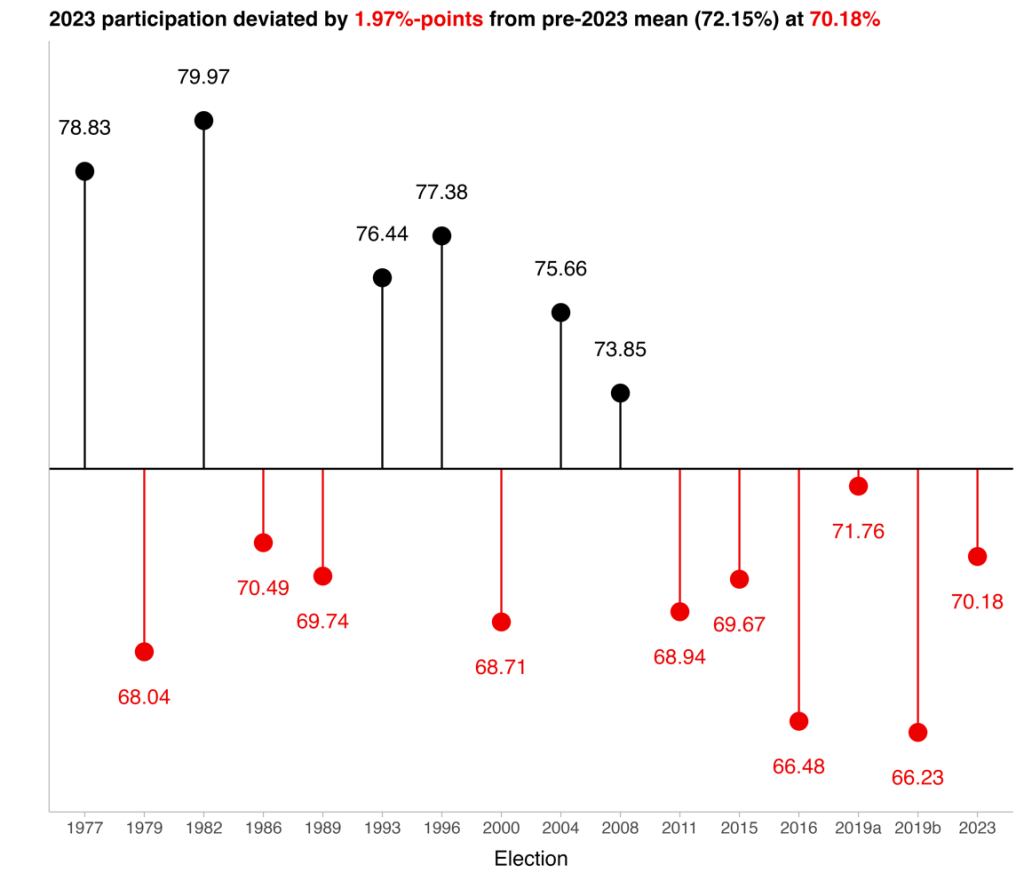Spain’s right-wing bloc fell short of winning enough support to form a government at the country’s general election on 23 July. Stuart J. Turnbull Dugarte writes the result represents vindication for the country’s Prime Minister, Pedro Sánchez, and a major defeat for the far-right party Vox.
In a nail-biting political showdown, Spain’s snap election left pundits and pollsters in awe as the unexpected unfolded. The centre-left Social Democratic Party, PSOE, defied all odds in a dramatic turn of events and, amid widespread speculation that the centre-right, Partido Popular (PP), was destined for triumph, the PSOE appears to have secured enough votes to have a chance of holding onto power.
Sánchez’s gamble
In May, Pedro Sánchez, Spain’s incumbent Prime Minister and leader of a progressive coalition between the PSOE and Unidas Podemos, surprised voters by calling an early election. The decision, which came the morning after the PSOE suffered electoral defeat in regional elections held on 28 May, was a political gamble. At the time Sánchez called the elections, the PSOE was polling around eight points behind the PP who, having just won the regional elections and having just elected a new leader within the past year, were enjoying something of a political renaissance.
The PP’s regional success, however, has likely been to the PSOE’s political advantage in the national arena. Despite being the most-voted party in a large number of Spain’s autonomous communities, the PP would come to rely on forming several parliamentary agreements with the country’s main far-right party, Vox, to form a government in these communities.
Vox has signed more than one hundred and forty agreements with the PP to support the formation of right-wing led local regional-level governments. The agreements, shown in Figure 1, include formal joint-governing coalitions in the communities of Castilla y León, Extremadura and Valencia.
Figure 1: Agreements between Vox and the Partido Popular in Spanish regional governments
Vox has rejected the idea that women are subjected to sexist violence, advocated for a repeal of liberal access to abortion and proposed prohibitions on the discussion of LGBTQ-inclusive material in classrooms. The potential role that the party would play in the formation of any future national-level right-wing government quickly became a core focus of the election campaign. This fear was epitomised by a now infamous campaign billboard in the centre of Madrid which depicts a mask of the PP’s leader, Alberto Nuñez Feijóo, being pulled away to reveal that of VOX’s candidate, Santiago Abascal.
In the three televised debates that took place during the campaign, there was a dedicated section spent on the potential electoral pacts that would emerge from the election given that polling made it clear no single party would likely be able to boast an absolute majority on their own. The last of these debates was marked by the absence of Feijóo, who opted not to attend – a decision, according to Sánchez, that was motivated by a desire to avoid being associated with Abascal.
Over the course of the election campaign, the PP’s lead over the PSOE diminished significantly and following several gaffes from Feijóo on the campaign trial, the PP’s prospects became increasingly deflated. Despite this convergence in polling performance – something that is not necessarily unexpected as a campaign gets underway – the PP remained the frontrunners and a Vox-PP coalition seemed the most likely outcome. However, the results on Sunday night were a different story.
Falling flat
Figure 2 summarises the main takeaways from the election, indicating the change in the vote share achieved by each of the main parties. As the polls suggested, the PP made gains, increasing their proportion of the vote from 20.99% to 33.04%. However, an important caveat in the interpretation of the PP’s rising vote share is that the party was competing for votes in a right-wing space that had dramatically changed since 2019.
Rather than competing in a crowded three-party space, the PP was able to consolidate its electoral support after the self-penned liberal centre-right party Ciudadanos opted to abstain from the election, ending the party’s short-lived presence on the national stage. Despite consolidating voters on the right, the 12-point change in the PP’s electoral fortunes fell short of landing the party the majority it hoped for. With a combined seat count of 169 in Spain’s 350-seat Congress, there is no viable parliamentary path for Feijóo to form a right-wing coalition.
Figure 2: Results of the 2023 Spanish general election
Rather than suffering an electoral defeat, the PSOE was able to boast an uptick in its support. The party gained more seats and votes than it did in 2019 despite the polls suggesting the reverse would happen. In a speech outside the party headquarters in Madrid, Pedro Sánchez spoke of the election result, and his party’s success, as being a signal of Spain’s rejection of the illiberal policies advocated by the right, including a PP that has been increasingly sympathetic with some of the talking points of Vox.
Importantly, despite some concerns about low levels of participation due to the elections falling during a heat wave – indeed, Feijóo claimed that Sánchez planned elections for July to depress turnout – participation was not particularly low. In total, 70.18% of eligible voters cast a vote, with two and a half million doing so by post. This turnout figure is not that far from the Spanish average of 72.15%.
Figure 3: Turnout in the 2023 Spanish general election compared with previous elections
The way forward from the election, despite the phoenix-like revival of Sánchez, remains uncertain in terms of the parliamentary arithmetic. While the combined forces of the PP and Vox are unable to reach the magic number of 176 seats that would provide the right-wing bloc with a parliamentary majority, Sánchez will face an uphill battle to bring together a diverse coalition of parties to remain in power as Spain’s Prime Minister.
Indeed, although Spain’s far-right nationalists – Vox – will not be the kingmaker in negotiations to form a government, this role is likely to now fall on Catalan nationalists. Social democracy and an explicitly anti-far-right campaign may have won the day, but the spectre of nationalism will remain an important political force in the months to come and political concessions will likely determine whether Spain will return to the polls before the end of the year.
Note: This article gives the views of the author, not the position of EUROPP – European Politics and Policy or the London School of Economics. Featured image credit: OSCAR GONZALEZ FUENTES/Shutterstock.com








In the interest of balance, if you’re going to insist on referring to Vox as ‘far right’ then you should also refer to Sumar as ‘far left’.